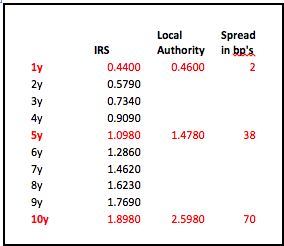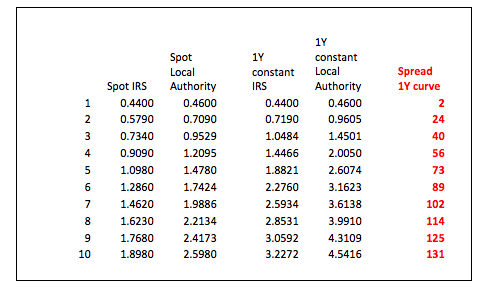How can Cash Management influence the Cash Conversion Cycle?
| 27-06-2016 | Olivier Werlingshoff |

How can the Cash Conversion Cycle (CCC) be optimized? The CCC measures the time the money is tied up in the sales and the production process before it’s converted into a cash in from customers. When translated in a formula this will be the DSO + DIO – DPO (Day’s Sales Outstanding + Day’s Inventory Outstanding – Day’s Payables Outstanding).
In this article I will focus on the DSO. Strictly, the DSO is the time it takes for invoices to be paid. I prefer to enlarge this, to the moment you received the order from the customer till the moment the money is on your main bank account.
How can the “enlarged” DSO be shortened with cash management products?
Let’s look at the customer first, how would he prefer to pay?
Card payments:
In the retail sector 50% of the transactions are made by card (credit & debit cards). The other 50% of the transactions are still done by cash. Card transactions are a fast and easy way to receive the money on your bank account. With contactless cards you can even minimize the transaction time, if there is a bottle neck, you can increase your sales by accepting those cards!
The process with cash transactions is more extensive and expensive. You have to save and collect the cash before dropping it at your bank. After a few days the money will appear on your bank account.
Be aware that there are reasons why customers still prefer to make cash payments. Last year I set up a test of 6 weeks of not accepting cash in one retail shop. The total sales dropped with 15%!
Mail with payment link:
When you have the mail addresses from you customers you could consider to send the invoice the same day by mail with a link to the Ideal website. This will encourage your client to choose the payment method you prefer. Furthermore you will save postal costs and paper costs by not sending paper invoices.
Foreign countries:
If you have customers in foreign countries, be aware of the local habits. For example in the US, most of the payments are done by cheques. In the UK and in France cheques are still used as payment instrument. The problem with cheques is that when receiving them, they have to be send back to the original bank before the money will be transferred to your account.
To fasten this process you could consider the possibilities of a local cheque lockbox. With a lockbox your client can send his cheque directly to a local address at a bank and the transactions can be processed immediately. The time that will be saved is the “post time” and the “process time” of the cheque.
International transfer:
If you prefer your customer to make an international transfer, it can be an option to open a local bank account. Depending on the number and the amount of transactions this could save you a lot of transfer costs. To get the money from your local bank account on your main account in The Netherlands there are a lot of cash pool instruments you can use. Jan Meulendijks has written an article last week about how to include foreign bank accounts into your cash pool.
SEPA:
In de SEPA region there are no differences in transfer costs between a national transfer and a transfer between SEPA countries. It is seen as one SEPA region without borders. You can mention your main IBAN number on your invoices and ask your customers to transfer the money direct to your main account.
But even with SEPA it could be an idea to hold a local bank account. In some countries customers still prefer to make transfers to a “national” bank account instead of an IBAN in another country. Some local governments even still oblige you to hold a local bank account for tax payment purposes!
As you can read,besides a good credit management system, there are a lot of cash management instruments that can be used to fasten the payments of your customers.

Owner of WERFIAD
Boek release : Mijn bedrijf verkopen?
| 24-06-2016 | Peter Schuitmaker |

Ik wil mijn bedrijf verkopen, wat komt daar allemaal bij kijken? Waar moet je rekening mee houden? Dat en meer beschrijft Peter Schuitmaker in zijn boek: Mijn bedrijf verkopen? Het doel van zijn boek is om mensen die hun bedrijf willen verkopen te helpen om de juiste stappen te nemen en niet te verdrinken in de vele aspecten die komen kijken bij het verkopen van een bedrijf.
Als u uw bedrijf gaat verkopen, komt er van alles op uw pad. U krijgt te maken met verschillende bedrijfseconomische, juridische en fiscale aspecten. Maar ook emotioneel gaat dit u raken.
Mijn bedrijf verkopen? Vragen komen er dan genoeg. Wat is mijn bedrijf waard? Op welke verkoopprijs kan ik rekenen? Hoe organiseer ik het verkoopproces? Hoe regel ik geheimhouding? Wat leg ik vast in de verkoopovereenkomst? Wat is mijn financiële betrokkenheid na de verkoop? Hoe is de risico-overgang geregeld? Hoe voorkom ik acute belastingheffing?
Mijn bedrijf verkopen? Hierover schreef ik een boek. Dit boek is primair geschreven voor de MKB ondernemer. Hij heeft met veel inspiratie en transpiratie een bedrijf opgebouwd. Maar eens komt het moment dat hij zijn onderneming wil overdragen. Dan volgt een spannend en uitdagend proces: de bedrijfsoverdracht.
Mijn bedrijf verkopen? Dit boek maakt van u geen vakspecialist. Dat is ook niet nodig. Daar hebt u uw overname-adviseur voor. Die moet u helpen om de juiste stappen te nemen. Om de juiste keuzes te maken, om voor u het pad naar een succesvolle bedrijfsoverdracht te effenen.
Mijn bedrijf verkopen? Dit boek draagt hopelijk wél bij aan het juiste begrip van de lastige en complexe materie. Zodat u op een goede manier sturing kunt geven aan het proces. En zodat u zo de juiste keuzes kunt maken. Met als eindresultaat: een succesvolle afronding van de overdracht van uw onderneming.

Auteur “Mijn bedrijf verkopen?”
Nieuwsgierig geworden? “Mijn bedrijf verkopen?” is binnenkort verkrijgbaar bij bol.com. Wij houden je op de hoogte!
Constructing a yield curve for local authority loans
| 22-06-2016 | Lionel Pavey |
 So far in this series we have constructed yield curves based on Interest Rate Swaps. This route was chosen as Swaps provide the benchmark for pricing many loan products. Let us look at constructing a yield curve for local authority loans. Yet again, the choice has been made for a product where prices are published on a daily basis.
So far in this series we have constructed yield curves based on Interest Rate Swaps. This route was chosen as Swaps provide the benchmark for pricing many loan products. Let us look at constructing a yield curve for local authority loans. Yet again, the choice has been made for a product where prices are published on a daily basis.
The data that is published is not as comprehensive as that for Swaps but, using the procedures shown before, we are still able to build a curve. Only 3 data points were published – 1 year, 5 year and 10 year. It is thus possible to build a 10 year curve – the data is as follows:

Going back to the principles employed when building the IRS curve we shall make a first attempt by using linear interpolation of the spreads – a reasonably obvious approach. I shall save you all the calculations and simply say that this approach leads to an implied 1 year constant maturity curve that is not completely smooth – there is a peak in the period starting in 4 years.
Obviously you could manually alter the prices to achieve a better curve or make use of a curve building model like Nelson & Siegel. Personal experience has resulted in my preference being to calculate the ratio between the local authority rates and the swap rates and allowing the model to find a best fit. Ratios are generally less volatile than the input rates allowing for a better fit. Eventually an implied local authority curve can be built as shown below:

As previously shown the spread is also monotonic – constantly rising. Consider the implications if we know that a 10 year loan has a spread of 70 basis points over swaps whilst the 1 year loan has a spread of only 2 basis points over swaps.
A 10 year spread can also be defined as the weighted average of all the underlying 1 year constant maturities, so let us investigate how this works in this model:

A 10 year spread of 70 basis points starts with a spread of 2 basis points in the 1st year rising in the 10th year to 131 basis points when compared to the underlying implied 1 year constant swap curve. As a treasurer it is important to know how rates are constructed and determine for yourself what the best approach is to your funding needs. Where do you think rates will be in the future, what will the spreads be, borrow for 10 years or borrow for 5 years and renegotiate? A fixed spread is therefore very advantageous for the lender.
No one knows the future but the ability to calculate the implied future price can assist in making decisions now regarding the future. Long dated fixed loans are difficult to break open leading to potential opportunity losses. Bullet loans are the easiest to price, but by focusing only on the cash flows and not their individual time buckets it is possible that the best decisions are not always made. Linear loans are less transparent when pricing but, yet again, a different time approach can be used to make the process simpler. Rollercoaster loans used in construction and infrastructure projects are the most opaque but can also be viewed in a different light if approached in another manner.
Next – Opportunity loss/profit. If I could turn back time or see into the future

Cash Management and Treasury Specialist – Flex Treasurer
Foreign bank accounts, how to include them in your cash pool
| 21-06-2016 | Jan Meulendijks |
 Significant balances on your foreign bank accounts which are really of better use in the country where your operation is? Include them in an automated cash pooling scheme so that all your funds are available in The Netherlands and no more unnecessary interest is paid!
Significant balances on your foreign bank accounts which are really of better use in the country where your operation is? Include them in an automated cash pooling scheme so that all your funds are available in The Netherlands and no more unnecessary interest is paid!
There are a number of reasons why you maintain bank accounts in other countries (I will explain the advantages of that in my next paper), but once this is the case, you need to control them in the most efficient way and at minimum costs.
Dutch banks who offer international cash management solutions have several tools to achieve this:
1. International Balance Reporting
The banks where you hold your accounts report them daily automatically into your multi-bank internet banking tool (e.g. Access Online from ABN AMRO); balances as well as transactions. With this tool you can also initiate local or cross border payments from this account.
Most ERP-systems can reconcile this account information automatically into your general ledger.
2. Cross Border Zero Balancing (CBZB)
In case your foreign accounts are held with subsidiaries of your Dutch bank, the balances can be automatically swept (daily) to your central cash pooling account in The Netherlands or be supplied with funds in case of shortage.
3. Multi-Bank Cash Concentration (MBCC)
In case your accounts are held with foreign partner-banks of your Dutch bank the alternate MBCC system can be used to achieve the same effect.
Now, once you have the Balance Reporting part in place plus one or both options CBZB and MBCC, not only all account information is made available to you on a daily basis, but also the balances are swept automatically daily into your central cash pooling account in the Netherlands!
Results:
- Automated reconciliation of account-information in your General ledger; no more loss of time/personnel processing data
- Interest optimisation (your use of bank credit is reduced with the balances that otherwise are in your foreign accounts)
- No manual handling
Setting up such an international cash management scheme involves some paper work and time (most of that at your bank’s side) but once it has been set up it is a major cost and trouble saver which you wish you had had 10 years sooner!

Jan Meulendijks
Cash management, transaction banking and trade professional
Walk the walk into FX exposure: my first baby steps
| 20-06-2016 | Pieter de Kiewit |
Being a treasury recruiter I know how to talk about many aspects in corporate treasury, never having to prove I understand and can execute. Apparently this is not necessary to do a proper recruitment job. As a small business owner I do have my miniature corporate treasury tasks. Below I want to describe the most complex FX issue I encountered so far. Not so much for the readers who are seasoned treasury professionals, but for my fellow entrepreneurs and others not dealing with FX on a daily basis.
A large, listed firm with a presence in various countries asked for my support in finding an interim treasury manager for a transition project. Doing what we do, this task was executed swiftly. The next steps were a bit more complex, given the fact that the assignment will be executed in Switzerland and The Netherlands and the interim manager is from the UK. Our previous cross border, non Euro payments were related to permanent placements, resulting in a single invoice. Most of these can easily be done via electronic banking. I know the bank in that case charges me a fee for the actual transfer and without sending me a quote will earn from making Euro’s out of other currencies. Perhaps I should have asked how much. I suspect I paid over 40 base points.
In this case, there will be many invoices related to one project, resulting in many transfer fees. The interim manager wants to be paid in GBP, if my client would pay in Euro’s this will lead to many Euro-GBP transfers. I am not too keen on that, I expect costs will be substantial. On top of this, the Brexit is in the news constantly creating a blurry situation for me. How to move forward? What is the advise of my bank? What do companies like NBWM or Monex tell me? Spots, forwards, swaps? Without going into detail this is where I stand.
My client is willing to pay me in GBP. With my bank I could open a GBP account quite swiftly. Instead of researching and managing this part of the FX risk I will invoice in GBP, making this a complete GBP project. This way I do not have to think about FX risk during the project. At the end of the whole project I will decide if my bank will convert my GBP in Euro’s or I will ask others. I do have to decide if I will accept the risk of the GBP collapsing or if I will hedge this risk. My costs are in Euro’s, who can predict the future for me?

Pieter de Kiewit
Owner Treasurer Search
Lionel Pavey about the German Bund Yield. Is there a solution?
| 17-06-2016 | Lionel Pavey |
This week’s headlines were all about the German Bund Yield hitting a historic low. On Wednesday we also published an article about this subject and asked our experts to respond. Expert Lionel Pavey reacts with a full article on the German Bund Yield and asks himself; is there a solution?
Possible reasons:
- Flight to quality – investors looking to place their money in a safe place
- Brexit referendum – polls suggest chance of exit greater than ever leading to uncertainty
- Quantitative easing – ECB policy of buying government bonds pushes bond prices up and decreases the yield
Since 2008 governments have attempted to kickstart their economies using monetary policy – lower rates and quantitative easing. The sellers of government bonds who receive cash do not appear to be either spending it or investing it – a report from Merrill Lynch states that fund managers are sitting on more cash than at any times since 2001 and have reduced their shareholdings to their lowest level in 4 years.
It would appear that all efforts by central banks via monetary policy have not succeeded. If government yield are persistently negative there is a possibility of stagflation and important investment decisions being deferred to a future date, leading to falling prices and a vicious downward spiral.
Is there a solution?
When I studied economics there were 2 schools of thought at the time – Milton Friedman and John Maynard Keynes. I have always felt that Keynes was discarded rather harshly by the monetarists.
Keynes stated that in recessions the aggregate demand of economies falls. In other words, businesses and people tighten their belts and spend less money. Lower spending results in demand falling further and a vicious circle ensues of job losses and further falls in spending. Keynes’s solution to the problem was that governments should borrow money and boost demand by pushing the money into the economy. Once the economy recovered, and was expanding again, governments should pay back the loans.
It is that last sentence that is pertinent. Keynes’ remedy runs countercyclical to the business cycle –instead of using all the money to buy up Government Debt, Government should borrow the money directly and embark on large projects to improve the infrastructure within a country. When the economy was revived Government should then repay the money borrowed and run a budget surplus.

Cash Management and Treasury Specialist – Flex Treasurer
TIPCO & TIS Webinar – Streamlining Your Treasury Processes: Trends in Payments and Reporting
| 16-06-2016 | treasuryXL |
 Dear community members, we would like to bring something to your attention: TIPCO and TIS joined forces to organise a noteworthy webinar on the 7th of July: TIPCO & TIS: Streamlining Your Treasury Processes: Trends in Payments and Reporting.
Dear community members, we would like to bring something to your attention: TIPCO and TIS joined forces to organise a noteworthy webinar on the 7th of July: TIPCO & TIS: Streamlining Your Treasury Processes: Trends in Payments and Reporting.
The treasuryXL team works hard to bring you the most relevant treasury events and courses. Are you organising an event or did you run into an event that’s not on our website yet? Please let us know by using the contact form or simply e-mailing [email protected].
Since we have been in close contact to both TIS and TIPCO for some time now, we know this webinar will be something interesting; they have their own solution that can be complementary for the already existing market. TIS and TIPCO have assured us the webinar focuses on bringing you new insights on your treasury processes. So, we would like to emphasize that it will not be a sales pitch.
Content of the webinar:
You’re involved with treasury topics in your organisation daily. You know how important it is to have a handle on your data. However, do you have the right tools and processes in place in order to keep your activities streamlined while also being able to report on the key information? Are you reaching maximum efficiency and accuracy within your department – or is there a better way forward?
You will learn how to:
- automate and standardise your payment transactions
- enhance transparency and control through liquidity and cash flows
- manage banking relationships and complex banking landscapes more efficiently
- improve your treasury reporting at the touch of a button
- reduce complexity and easily link subsidiaries
Speakers:
 Hubert Rappold, CEO and Co-founder, TIPCO
Hubert Rappold, CEO and Co-founder, TIPCO
 Jörg Wiemer, CSO and Co-founder, TIS
Jörg Wiemer, CSO and Co-founder, TIS
Practical info:
Date: Thursday, 07th July 2016
Time: 15:00 – 15:45 CET
Duration: 45 minutes
Language: English
Follow up
Missed the TIPCO & TIS Webinar? Don’t worry we got you the webinar recording.
Find more treasury related events on our event calendar, we also promote treasury related education on our education&training page.

Stephanie Derkse
Community Manager
Talk of the day: German Bund Yield Below 0%
| 15-06-2016 | Udo Rademakers, Rob Söentken, Douwe Dijkstra & Lionel Pavey |

For the first time ever the German bund yield hit negative territory. The ‘Deutsche Welle’ writes: “With the prospect of Britain leaving the European Union looming ever larger ahead of referendum in 9 days, global investors are increasingly fleeing to safe havens such as German debt and Japenese currency. As a result, the yield on Germany’s benchmark 10-year debt fell into negative territory for the first time in its history on Tuesday. ” (DW.com) We asked some of our experts to give their opinion on this news:
 Udo Rademakers
Udo Rademakers
“Billions of Euro´s are invested into sovereign debt, even if meanwhile investors need to pay for this. German yield prices can meanwhile compete with Japan and Swiss rates (all below 0). The mainstream media explains this development as “concerns about the economic and political risks of a Brexit” and “concerns about the state of global growth”. However, the longer term trend since the 1980´s has been downwards and we now see a kind of (last?) acceleration in price.
Knowing the challenges Europe (and Germany) is facing, I think it is a matter of time before we could expect a spike in the rates again….. .I would place my bet in other markets.
Every trend is coming to an end…….”
Rob Söentken 
“Not even a month ago markets were discounting the impact of the Brexit referendum. Now in a matter of weeks the odds have swung back from around 25% in favor of leaving to 42%. The increased media attention and figures (true or false) being thrown around are making voters run to register to vote. Apparently it’s mostly younger voters, who tend to be more in favor of staying. It is said that a turnup above 60% is favorable to the ‘remain’ vote. Still both camps are becoming more and more committed.

“Who would have thought this a few years ago, the interest rate on 10- year German government bonds below zero percent. For some time we hear our banks and advisors recommending to fix our interest rate exposure because its “now or never”.
More on this topic in my article which will be published on Friday.”
What’s your opinion on this news? Let us know in the comment section below.

 De historisch lage rente, op 15-06-2016 publiceerden we al een
De historisch lage rente, op 15-06-2016 publiceerden we al een 


 Simon Knappstein
Simon Knappstein

